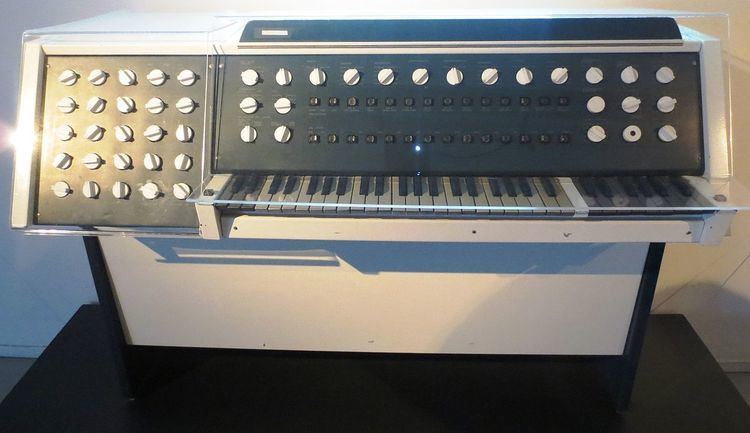 | ||
The Subharchord is a German electronic musical instrument featuring subharmonic synthesis.
Contents
History
In 1950s Germany, in the wake of musique concrète, the first fully electronic compositions were written. During this period many countries established electronic music studios to discover and explore these new worlds of sound.
In Germany, new music was composed and experiments conducted on electronic equipment that often came originally from the physics lab or radio. However, development in the East and the West differed considerably. The political division of Germany after World War II led to the foundation of two politically independent states in 1949, geographically neighbours yet entirely separate: the German Democratic Republic (GDR) in the east and the Federal Republic of Germany (FRG) in the west.
In the years that followed, each state defined its own cultural policy. One result was that young artists and musicians, who saw themselves as the avant-garde, were valued and tolerated differently in the two states. In the West, from the outset it was easier for musicians to remain independent and to experiment relatively unhampered. For example, at the famous WDR Studio für elektronische Musik in Köln, many new works were written by composers such as Herbert Eimert, Karlheinz Stockhausen, and Gottfried Michael König. The publications that came out of the WDR studio had an international audience. In other studios, such as Milan, the Rome, Eindhoven, Brussels, Gravesano, and New York, experiments with musical structures and technical innovations were also ongoing.
Invention
This revolutionary development in music, together with the use of new electronic sources of sound, was followed with great interest in East Berlin. Like the rest of the country, the city of Berlin was divided politically into East and West. In the competitive struggle between the two systems, the GDR did not merely want to be part of international developments, it wanted to take the lead.
Thus, around 1960, technical experts at the “Labor für Akustisch-Musikalische Grenzprobleme” (laboratory for problems at the acoustics/music interface) began with the construction of a sound-generating device, which would be a compact sound lab and centerpiece of an electronic music studio; furthermore, it would be unrivaled and unsurpassed. The East German composers would have an instrument at their disposal that was superior to all comparable inventions in the studios of the Western world.
This wonder-machine utilized microelectronics, which was new at the time. The machine’s concept was based on the mixing of so-called subharmonic sounds. In this respect its model was the Trautonium, a German invention from the 1930s.
Mixtur-trautonium
In Alfred Hitchcock's film The Birds, the rather menacing sounds of these usually harmless creatures were produced synthetically on an electronic instrument, a Mixturtrautonium — a further development of the Trautonium.
The Mixtur-trautonium is a special case in the history of electronic music instruments, since it uses the afore mentioned subharmonic mixtures to generate sound. The sounds produced by conventional instruments and in the natural world are a combination of a fundamental with a series of harmonic overtones above it. Subharmonic sounds are produced by dividing the fundamental frequency, resulting in subharmonics, or "undertones".
Subharmonics only exist naturally in bells and steel plates and differ from the sounds produced conventionally by synthesizers and software programmes for electronic music. It appeared that the world of sound produced by mixing subharmonics would be forever dominated by the only existing instrument, the Mixturtrautonium, and its constructor and player, Oskar Sala. Nobody else had ever mastered or played Sala’s instrument, and when he died, it seemed that the sound world of subharmonics was lost.
Rediscovery in 2000
In the course of extensive research on the history of electronic music instruments, in 2000 Manfred Miersch, a Berlin artist and musician, made a remarkable discovery: the Trautonium is not the only instrument of its kind; another exists that produces subharmonic sounds — the "Subharchord".
As described above, this instrument was invented in the GDR under difficult technical conditions, but using the latest technology available. However, the Subharchord differs from the Mixturtrautonium in key respects. The Subharchord has a keyboard and is played like an organ, whereas the Mixturtrautonium’s manual is a resistor wire over a metal plate, which is pressed at various points to create sound (like a ribbon-controller), a rather difficult procedure. In addition, the Subharchord possesses considerably more possibilities than the Mixturtrautonium for generating and manipulating sounds.
Miersch succeeded in tracking down and unearthing long-forgotten instruments, thus saving the Subharchord from oblivion. With his publication of a four-part series in the German magazine Keyboards in 2003 and construction of a website (www.subharchord.com) in 2002/2003, Miersch introduced the Subharchord to a wider audience. As a result of Miersch’s activities, one of the surviving instruments has now been restored.
Like its West German counterpart, the Trautonium, the East German Subharchord was a favourite choice for film soundtracks. Karl-Ernst Sasse, former conductor of the DEFA (East German Film Company) Symphony Orchestra, worked with the subharchord in Dresden on the soundtracks of science fiction classics, such as Signale. The subharchord was also used for many of the DEFA’s cartoons.
